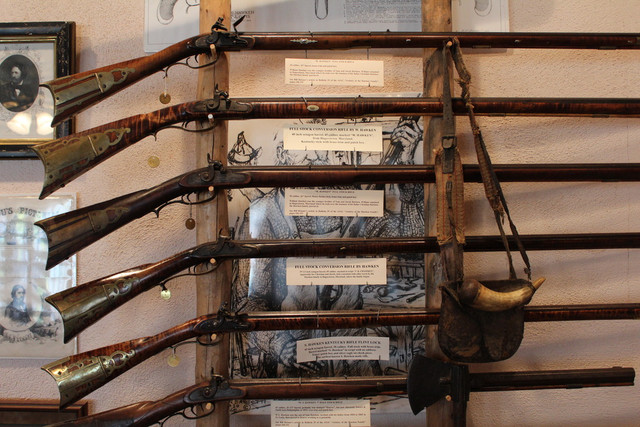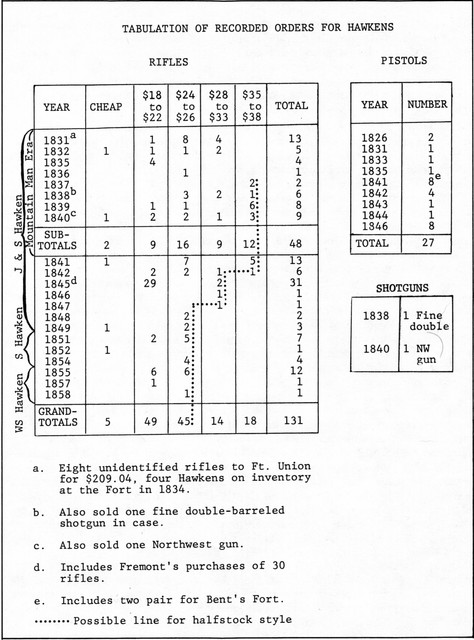plmeek
40 Cal.
I agree, Zonie, the TC Hawken is very similar to some real period rifles. I would not refer to it as a "make believe gun", but it would have been more accurate had they called it a Plains Rifle or even a California Rifle. It may not have sold so well, though.
So far no J&S Hawken half stock rifles in flint have been found. Other gunsmiths were making flintlock half stock rifles at the time, and of course, the British sporting rifle by 1800 was typically a half stock rifle. The Hawken brothers could very well have worked on some of these guns in the late 1820's as cleaning and repairing guns was a big part of their business. There is no reason that they couldn't have made some, we just don't know for sure.
I haven't seen a meaningful study on the caliber of Hawken rifles. As Herb has pointed out several times on this forum, the typical way museum curators and collectors have measured bore size, more often than not, indicate too large a bore. The method I speak of is using a modern shotgun bore gauge like the one below. Most antique guns have slightly enlarged muzzles. Some of this may be from rod wear, but others were probably made this way when new so that the shooter could "thumb start" the ball, then push it down with the ramrod. A short starter, which appears to be a modern invention, was not needed. Barrels with an odd number of grooves and lands cannot be accurately measured with this type of gauge, either, since one side of the gauge would be on a land while the other side would be in a groove.
The Wrong Way to Measure the Bore of an Antique Rifle

I've studied the records of the rifles that J. Joseph Henry made for the America Fur Company. I need to finish writing that study up and send it to a magazine or post it here on this forum, but the conclusions are that 95% of the rifles ordered by the AFC for the St. Louis market were between 32 balls per pound and 40 balls per pound. This is equivalent to between .50 and .54 caliber. Two-thirds of the orders were for rifles to carry 32 balls per pound or .54 caliber. This likely indicates that the preferred calibers for the mountains and plains were between .50 and .54 caliber with .54 caliber being the most common.
I wonder if any half stock rifles were made as flintlocks...
So far no J&S Hawken half stock rifles in flint have been found. Other gunsmiths were making flintlock half stock rifles at the time, and of course, the British sporting rifle by 1800 was typically a half stock rifle. The Hawken brothers could very well have worked on some of these guns in the late 1820's as cleaning and repairing guns was a big part of their business. There is no reason that they couldn't have made some, we just don't know for sure.
just what was the standard HAWKEN cal,50 or 54? I am shure that they would make it in any CAL. that a customer wanted.
I haven't seen a meaningful study on the caliber of Hawken rifles. As Herb has pointed out several times on this forum, the typical way museum curators and collectors have measured bore size, more often than not, indicate too large a bore. The method I speak of is using a modern shotgun bore gauge like the one below. Most antique guns have slightly enlarged muzzles. Some of this may be from rod wear, but others were probably made this way when new so that the shooter could "thumb start" the ball, then push it down with the ramrod. A short starter, which appears to be a modern invention, was not needed. Barrels with an odd number of grooves and lands cannot be accurately measured with this type of gauge, either, since one side of the gauge would be on a land while the other side would be in a groove.
The Wrong Way to Measure the Bore of an Antique Rifle

I've studied the records of the rifles that J. Joseph Henry made for the America Fur Company. I need to finish writing that study up and send it to a magazine or post it here on this forum, but the conclusions are that 95% of the rifles ordered by the AFC for the St. Louis market were between 32 balls per pound and 40 balls per pound. This is equivalent to between .50 and .54 caliber. Two-thirds of the orders were for rifles to carry 32 balls per pound or .54 caliber. This likely indicates that the preferred calibers for the mountains and plains were between .50 and .54 caliber with .54 caliber being the most common.














